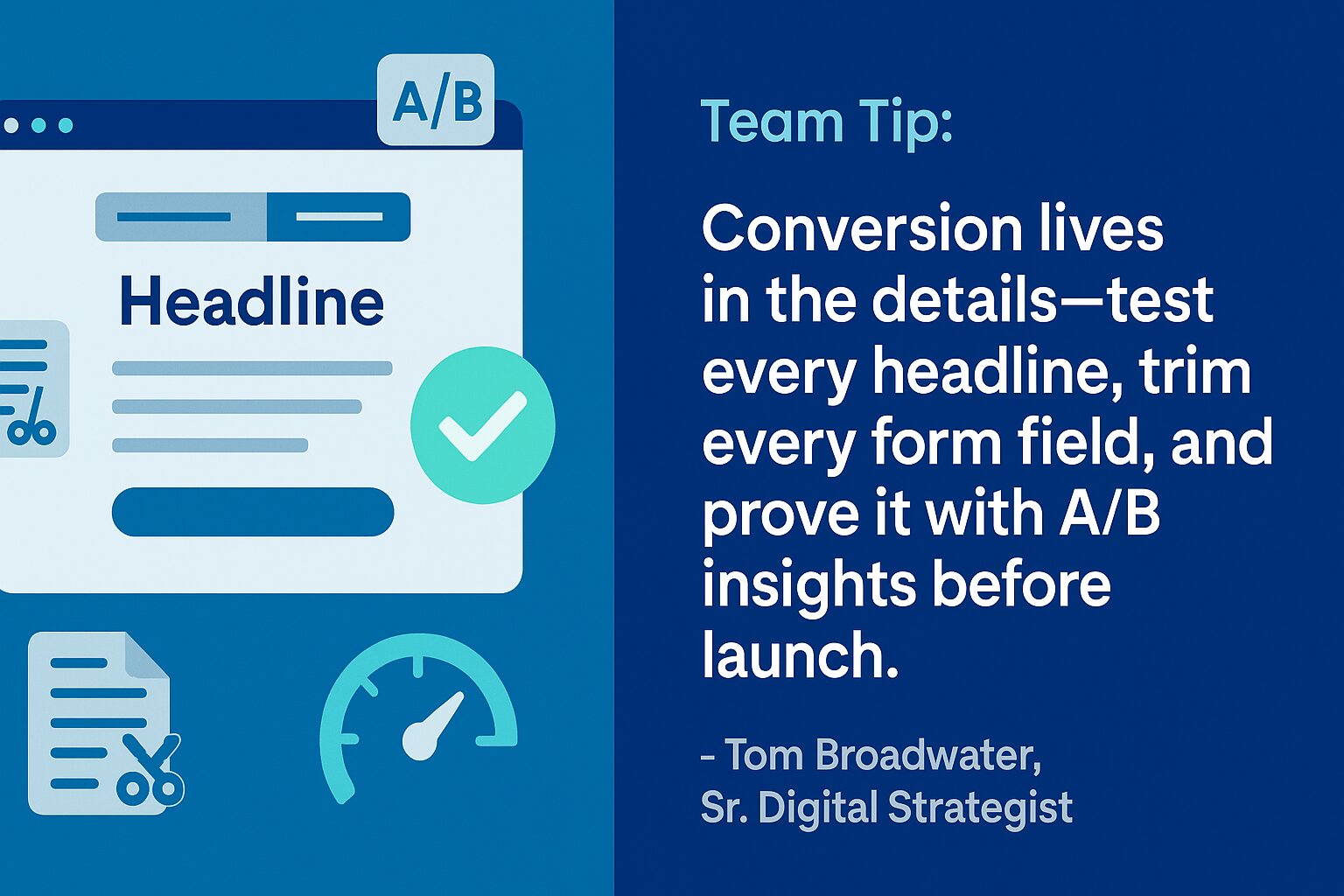TL;DR:
-
Lead with a Clear, Outcome-Focused Headline: Your headline should immediately answer “what’s in it for me?” using simple, benefit-driven language that speaks to your audience’s pain points.
-
Keep It Focused: One CTA, One Goal: Remove distractions. Use a single, visually distinct CTA repeated strategically on the page, with concise, specific copy like “Get the Guide” or “Request a Demo.”
-
Make Your Forms Short, Smart, and Functional: Limit forms to 3–5 essential fields. Test every form for functionality, and use tools like progressive profiling to avoid overwhelming new visitors.
-
Support with Copy That Converts: Structure your messaging around:
-
Problem → Solution → Value → Proof: Use testimonials, stats, or client logos to build trust and speak directly to your buyer’s needs without jargon.
-
-
Design for Speed, Mobile, and Optimization: Fast-loading, mobile-friendly pages convert more. Test layouts, align landing page content with your campaign messaging, and use A/B testing and SEO best practices to continually improve performance.
You launched the campaign, shared the ads, promoted the asset and waited. But the results? Disappointing. The traffic trickled in, bounce rates stayed high, and the form submissions never materialized.
For many marketing managers, especially in B2B manufacturing, this story is all too familiar. The landing page looked clean and on-brand, but it didn’t convert. And with limited resources and high expectations, you can’t afford to keep launching pages that underperform.
The good news? High-converting landing pages are not a mystery. With the right structure, content, and strategy, you can build pages that actually move visitors to take action.
Why Landing Pages Matter More Than Ever
Landing pages are where campaigns either succeed or stall. Whether you’re promoting a gated whitepaper, demo request, or product showcase, these pages serve a specific role: converting interest into action.
When buying cycles are long and decisions more complex, landing pages must do even more. They need to educate, reassure, and guide visitors quickly and clearly.

The Building Blocks of a High-Converting Landing Page
Before diving into design details, let’s cover the fundamentals.
1. A Clear, Benefit-Driven Headline
The headline is the first thing a visitor sees. It must immediately communicate what the offer is and why it matters.
- Use action-oriented language
- Focus on outcomes, not features
- Avoid jargon or overly broad claims
Example:
“Download the Guide to Reducing Production Downtime by 20%”
2. One Focused Call-to-Action (CTA)
Too many choices create confusion. A strong landing page has a single, clear CTA, usually in the form of a button or short form.
- Place the CTA above the fold and repeat it farther down the page
- Use specific language like “Get the Guide” or “Request a Demo”
- Ensure the CTA stands out visually
3. A Short, Smart Form
Long forms kill conversions, especially in manufacturing, where trust builds slowly. Ask only for the information you truly need at this stage.
Best practices:
- 3 – 5 fields max (e.g., Name, Email, Company, Role)
- Consider progressive profiling if using a tool like HubSpot
- Always test the form yourself. Broken forms are conversion killers
4. Persuasive Copy That Speaks to the Buyer
The copy should connect to real pain points and show how your solution addresses them.
Structure your message like this:
- Problem: Call out what your visitor is struggling with
- Solution: Introduce your offer as the answer
- Value: Highlight what they’ll gain by converting
- Proof: Add trust signals like stats or testimonials
Keep the language clear, confident, and tailored to your audience, not overly technical, unless you’re speaking directly to engineers or technical buyers.
5. Trust Builders and Proof Points
B2B buyers, especially in manufacturing, need to validate their decision. Help them say yes with supporting proof.
Add elements like:
- Client logos
- Case study snippets or testimonials
- Data points or certifications
- Awards or press mentions
Even a short quote can dramatically improve credibility.
6. A Mobile-Friendly, Fast-Loading Experience
Page speed and usability directly affect conversion rates. A beautiful page that loads slowly or breaks on mobile isn’t doing its job.
Make sure:
- Images are compressed
- Layouts are responsive
- CTA buttons are easy to tap
- Page speed scores are healthy across devices
This is where strong website support and development practices play a key role.
Advanced Tips for Even Better Performance
Once you’ve nailed the basics, here’s how to take your landing pages to the next level.
Optimize with A/B Testing
Test different:
- Headlines
- Button copy or colors
- Images or hero sections
- Form placements
Just be sure to change one element at a time so you can track what’s making the impact. This is a key pillar of conversion rate optimization.
Align With Campaign Sources
If your landing page is tied to paid media management, ensure the message matches the ad copy. Consistency improves trust and follow-through.
And don’t forget to use tracking URLs (UTMs) so you can segment performance by source.
Keep SEO in Mind
Even if your landing page is campaign-specific, SEO matters. Well-structured pages with optimized headings, image alt text, and internal links can increase discoverability and value over time.
How 3 Media Web Can Help
At 3 Media Web, we help manufacturing marketers build, test, and optimize landing pages that actually convert.
We support your team with:
- Custom web design and development tailored to your brand and audience
- Strategic input on copy, structure, and form UX
- Conversion optimization based on real-time analytics and heatmaps
- A/B testing setup and campaign-specific variations
- Website support to keep your pages fast, functional, and accessible
Whether you need one page or a full library of templates, we’ll help you turn more clicks into real results.
